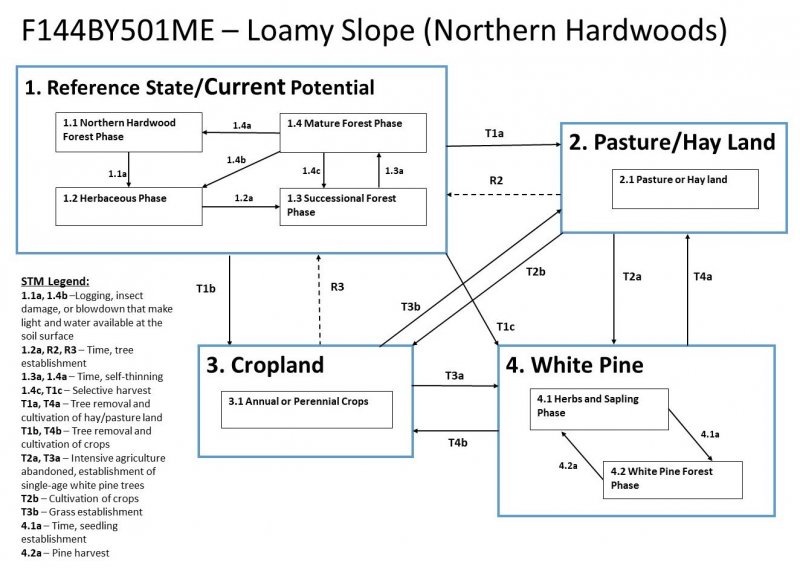
Natural Resources
Conservation Service
Ecological site F144BY501ME
Loamy Slope (Northern Hardwoods)
Last updated: 5/13/2025
Accessed: 12/22/2025
General information
Provisional. A provisional ecological site description has undergone quality control and quality assurance review. It contains a working state and transition model and enough information to identify the ecological site.
MLRA notes
Major Land Resource Area (MLRA): 144B–New England and Eastern New York Upland, Northern Part
This major land resource area (MLRA) is in Maine (56 percent), New Hampshire (22 percent), Vermont (14 percent), Massachusetts (6 percent), Connecticut (1 percent), and New York (1 percent). It makes up about 22,728 square miles (58,864 square kilometers). The MLRA consists of a relatively young landscape shaped by the Laurentide Ice Sheet, which covered the region from 35,000 to 10,000 years ago. Rolling hills of dense basal till converge on ridges of shallow bedrock that were scoured by glacial ice. River valleys that were flooded by melting glacial water or seawater house large expanses of glacial outwash and stratified drift in inland areas and, to a lesser extent, glaciomarine and glaciolacustrine sediment deposits in coastal areas. Organic bogs, ablation till, and alluvial flood plains make up the remaining portions of the MLRA.
The soils in this region are dominantly Entisols, Spodosols, and Inceptisols. They commonly have a fragipan. The dominant suborders are Ochrepts, Orthods, Aquepts, Fluvents, and Saprists. The soils in the region dominantly have a frigid soil temperature regime with some cryic areas at higher elevation, a udic soil moisture regime, and mixed mineralogy. Most of the land is forested, and 98 percent is privately owned. Significant amounts of forest products are produced including lumber, pulpwood, Christmas trees, and maple syrup. Principal agricultural crops include forage and grains for dairy cattle, potatoes, apples, and blueberries. Wildlife habitat and recreation are important land uses. Stoniness, steep slopes, and poor drainage limit the use of many of the soils.
Classification relationships
NRCS:
Land Resource Region: R—Northeastern Forage and Forest Region
MLRA: 144B—New England and Eastern New York Upland, Northern PartMLRA resources
Major Land Resource Area (MLRA): 144B–New England and Eastern New York Upland, Northern Part
Ecological site concept
This site occurs mostly on well- to moderately well-drained loam soils and associated somewhat poorly-drained soils. Bedrock is greater than 20 inches below the mineral soil surface. Soils may be underlain by a densely compacted till layer. This site is commonly found on backslope and footslope positions but may occur on flats or any number of landforms. The vegetation is characterized by northern hardwoods, particularly sugar maple, red maple, yellow birch, red oak and beech, with diverse hardwood associates. Shallower and wetter inclusions in this site typically produce more softwoods, including red spruce, white pine, hemlock, northern white cedar, and balsam fir. This site is likely over-mapped. Perhaps a Silty Slope (mixed wood) concept could reflect consistent, meaningful patterns between vegetation and soil properties. Further field work is required.
Associated sites
| F144BY502ME |
Loamy Till Toeslope The somewhat poorly- and poorly-drained Loamy Till Toeslope site often occurs downslope of the moderately well- and well-drained Loamy Slope site |
|---|---|
| F144BY702ME |
Shallow and Moderately-deep Till The Shallow and Moderately Deep Till site often occurs upslope of the Loamy Slope site, where much of the soil area is less than 20 inches deep to bedrock. |
Similar sites
| F144BY506ME |
Semi-rich Till Slope The Semi-rich Till Slope site has similar soil texture and wetness, but is distinguished by higher soil nutrients derived from calcareous parent material (such as limestone), as evidenced by high soil pH and rich site indicator species. |
|---|---|
| F144BY402ME |
Clay Hills Clay Hills occur on finer-textured soils, usually of glaciomarine or glaciolacustrine origin, and produces more mixedwood stands, while the Loamy Slope site occurs on till soils that are typically coarser in texture and produces more hardwood species. |
| F144BY504ME |
Enriched Loamy Cove The Enriched Loamy Cove site has similar soil texture and wetness, but is distinguished by higher soil nutrients which accumulate in protected cove setting and are evidenced by high soil organic matter and rich site indicator species. . |
| F144BY502ME |
Loamy Till Toeslope The Loamy Till Toeslope is somewhat poorly- and poorly-drained, supporting wetter species and more softwoods than the moderately well- and well-drained Loamy Slope site. |
Table 1. Dominant plant species
| Tree |
(1) Pinus strobus |
|---|---|
| Shrub |
Not specified |
| Herbaceous |
Not specified |
Click on box and path labels to scroll to the respective text.
